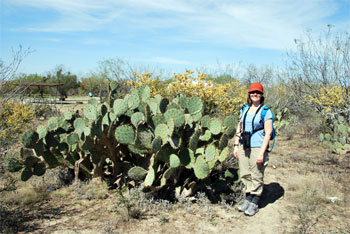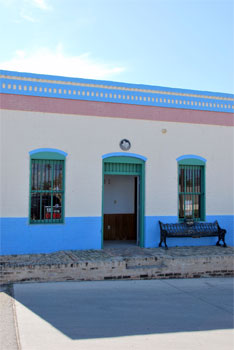 Standing on the northern edge of the Rio Grande River looking across at Mexico, the valley looked pretty small but there was a special feeling at this historical river frontier. The Rio Grande Valley’s rich history stems from the many people who struggled to make this area their home, from Spanish conquistadors and Mexican revolutionaries, to Texas Rangers and Civil War generals.
Standing on the northern edge of the Rio Grande River looking across at Mexico, the valley looked pretty small but there was a special feeling at this historical river frontier. The Rio Grande Valley’s rich history stems from the many people who struggled to make this area their home, from Spanish conquistadors and Mexican revolutionaries, to Texas Rangers and Civil War generals.
The Rio Grande Valley, known simply as “the Valley” or “South Texas”, extends roughly from Zapata in the upper valley to Brownsville in the lower valley where the river eventually flows into the Gulf of Mexico. During my recent trip to the Rio Grande Valley (RGV) in February 2009, I realized there are many reasons to make this a must-see destination. By the time the trip was wrapping up, I didn’t want to leave because there was still much to explore. I will definitely return again and here’s why:
1. Variety is the spice of life
Depending on your mood, you can stroll through a small historic town, take a bike ride in a state park, or relax on a sandy beach on South Padre Island. All of these can be found within a short drive, depending where you stay. If your base is somewhere central, such as McAllen, Alamo, or Weslaco, it’s about a 1.5 hr drive to go deep sea fishing at South Padre Island, or the same time to travel to the Upper Valley to check out the desert at Falcon State Park.
2. Balmy breezes
 The warm weather in the RGV is a great escape from winter chills. The lower valley can be more humid but it’s comfortable with a good breeze blowing in from the Gulf. From December to March, the average high is about 70-80 degrees (21-27 °C), with little rain (average 1 inch per month). January is the coolest month with a normal minimum of about 50 degrees (10 °C). The mild weather is one reason many “Winter Texans” move down to Texas every year to spend their winters camping in RV’s.
The warm weather in the RGV is a great escape from winter chills. The lower valley can be more humid but it’s comfortable with a good breeze blowing in from the Gulf. From December to March, the average high is about 70-80 degrees (21-27 °C), with little rain (average 1 inch per month). January is the coolest month with a normal minimum of about 50 degrees (10 °C). The mild weather is one reason many “Winter Texans” move down to Texas every year to spend their winters camping in RV’s.
3. No need to break the bank
In these tough economic times, staying in the Valley is very affordable. Accommodation is available at standard rates at chain hotels, but if you ask around there are some great deals at bed and breakfasts, and smaller hotels. For example, a small historical hotel in Alamo (the Alamo Inn), offers 1 bedroom suites for about $45 per night, with 24 hour self-serve breakfast for $3 per person. A good deal and the owners are very friendly and helpful. Other towns also offer bed and breakfasts so check them out.
4. It’s for the birds
Literally! Birdwatchers flock here from all over the globe to visit the Rio Grande Valley. This is a prime birdwatching spot in the continental U.S. for diversity, especially during winter and spring. In addition to abundant waterbirds and shorebirds, many species of forest birds visit from Mexico, plus huge numbers of small birds stop here every spring to rest before continuing their northward migration from Central and South America to northern Canada. Many of the national wildlife refuges offer free guided bird walks in the morning for beginners and experts alike. Several World Birding Centers have been developed in the Rio Grande Valley with the purpose of educating and raising awareness of the importance of this area for birdlife.
5. Poncho Villa
Learn about this infamous Mexican Revolutionary General at one of the several museums and historic sites scattered along the Valley. One of the oldest towns is Roma, located in the upper Rio Grande Valley, and founded in 1765 as part of a Mexican colony. The Roma Historical Museum provides more information about the town’s role as an important riverboat shipping point. Other museums such as the Museum of South Texas History in Edinburg and the Historic Brownsville Museum offer more insights into the rich history of the RGV.
6. Wild cats!
 No, it’s not the local sports team. The vast network of National Wildlife Refuges, sanctuaries and other nature reserves in the Valley support some endangered wild cats, such as the beautifully spotted ocelot and the elusive jaguarundi. Bobcats are more common and can be seen in many parks like Santa Ana National Wildlife Refuge. Other subtropical critters to be seen include colourful butterflies and small lizards.
No, it’s not the local sports team. The vast network of National Wildlife Refuges, sanctuaries and other nature reserves in the Valley support some endangered wild cats, such as the beautifully spotted ocelot and the elusive jaguarundi. Bobcats are more common and can be seen in many parks like Santa Ana National Wildlife Refuge. Other subtropical critters to be seen include colourful butterflies and small lizards.
7. Hit the road
Although there is no large airport, there are several options to fly into regional airports at McAllen, Harlingen and Brownsville, the biggest city in the vicinity with a population of 175,000. Other ways to get here are to fly into San Antonio or Houston and drive south. It takes about 5 hrs to drive from San Antonio and 7 hrs from Houston and freeways are easy to navigate. It is beneficial to have a rental car to explore the Valley.
8. Good eats
If you have a hankering for real Tex-Mex food, you’ve come to the right place. There are also many spots to fill up on BBQ grub. Willy’s BBQ is a cafeteria style restaurant in Alamo that serves tasty food at great value. You also don’t want to miss out on Gulf coast seafood. Dirty Al’s on South Padre Island is always hopping and the fried shrimp is to die for, plus you don’t need to shell out a fortune – no pun intended.
9. Off the beaten track
Many people have discovered all the great things the RGV has to offer, like the Winter Texans, world class birdwatchers, and spring breakers at South Padre Island. Yet it’s still easy to get away from the tourist scene and find quiet parks, small towns or other interesting places. The Rio Grande Valley is certainly not undiscovered, but it doesn’t have that busy touristy feel and offers an affordable alternative to other sun destinations.